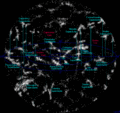1 E-10 m facts for kids
To help you understand how incredibly small things can be, this page lists different lengths. We're going to explore sizes between 100 picometers (pm) and 1 nanometer (nm). These are tiny measurements, much smaller than anything you can see with your eyes!
A picometer is one trillionth of a meter (0.000,000,000,001 meters). A nanometer is one billionth of a meter (0.000,000,001 meters). To give you an idea, a nanometer is about 100,000 times smaller than the width of a human hair!
Contents
Exploring Tiny Lengths: Picometers and Nanometers
When we talk about picometers and nanometers, we are usually looking at the size of atoms and molecules. These are the basic building blocks of everything around us.
The Size of Atoms
Atoms are super small! Their size is often measured by their "covalent radius" or "van der Waals radius." Think of these as different ways to measure how much space an atom takes up.
- 100 pm: This is about the size of an ångström, another unit used for very small lengths. It's also the covalent radius of a sulfur atom.
- 120 pm: The van der Waals radius of a neutral hydrogen atom. Hydrogen is the smallest and lightest atom.
- 126 pm: The covalent radius of a ruthenium atom.
- 135 pm: The covalent radius of a technetium atom.
- 153 pm: The covalent radius of a silver atom.
- 155 pm: The covalent radius of a zirconium atom.
- 175 pm: The covalent radius of a thulium atom.
- 225 pm: The covalent radius of a caesium atom.
How Atoms Connect: Bonds and Structures
Atoms often join together to form molecules and larger structures. The distance between atoms when they are bonded is also measured in picometers.
- 154 pm: This is the typical length of a bond between two carbon atoms. Carbon is a key element in all living things.
- 340 pm: The thickness of a single layer of graphene. Graphene is an amazing material, just one atom thick, and very strong.
- 356.68 pm: The width of a diamond's basic building block, called a unit cell. Diamonds are known for being incredibly hard.
- 403 pm: The width of a lithium fluoride cell.
- 560 pm: The width of a sodium chloride cell. This is the basic unit of table salt.
The Size of Molecules
Molecules are made of two or more atoms joined together. Some molecules can be quite large, even at this tiny scale.
- 500 pm: The width of an alpha helix protein. Proteins are vital molecules in our bodies, and many have this spiral shape.
- 700 pm: The width of a glucose molecule. Glucose is a simple sugar that our bodies use for energy.
- 900 pm: The width of a sucrose molecule. Sucrose is common table sugar.
Other Tiny Measurements
- 200 pm: This is the highest resolution of a typical electron microscope. These powerful microscopes allow scientists to see things as small as individual atoms.
- 780 pm: The average width of a quartz cell. Quartz is a common mineral found in rocks.
- 820 pm: The average width of an ice cell.
- 900 pm: The average width of a coesite cell. Coesite is a very dense form of silica, found in places where rocks have been under extreme pressure.
Images for kids
-
A paramecium is around 300 μm long.
-
An average red ant is about 5 mm long.
-
An average human fingernail is about 1 cm wide.
-
An adult human foot is about 28 centimetres long.
-
A blue whale has been measured as 33 metres long; this drawing compares its length to that of a human diver and a dolphin.
-
The Strait of Gibraltar is 13 kilometres wide.
-
Distance marker on the Rhine: 36 (XXXVI) myriametres from Basel. The stated distance is 360 km; comma is the decimal separator in Germany.
-
The Suez Canal is 163 kilometres long.
-
From largest to smallest: Jupiter's orbit, red supergiant star Betelgeuse, Mars' orbit, Earth's orbit, star R Doradus, and orbits of Venus, Mercury. Inside R Doradus's depiction are the blue giant star Rigel and red giant star Aldebaran. The faint yellow glow around the Sun represents one light-minute. Click image to see more details and links to their scales.
-
Sedna's orbit (left) is longer than 100 Tm, but other lengths are between 10 and 100 Tm: Comet Hale-Bopp's orbit (lower, faint orange); one light-day (yellow spherical shell with yellow Vernal point arrow as radius); the heliosphere's termination shock (blue shell); and other arrows show positions of Voyager 1 (red) and Pioneer 10 (green). Click on image for larger view and links to other scales.
-
Largest circle with yellow arrow indicates one light-year from Sun; Cat's Eye Nebula on left and Barnard 68 in middle are depicted in front of Comet 1910 A1's orbit. Click image for larger view, details and links to other scales.
-
Lengths with order of magnitude 1e17m: yellow Vernal Point arrow traces hundred light-year radius circle with smaller ten light-year circle at right; globular cluster Messier 5 in background; 12 light-year radius Orion Nebula middle right; 50-light-year-wide view of the Carina Nebula bottom left; Pleiades cluster and Bubble nebula with similar diameters each around 10 light-years bottom right; grey arrows show distances from Sun to stars Aldebaran (65 light-years) and Vega (25 light-years).
-
Lengths with order of magnitude 1e18m: thousand light-year radius circle with yellow arrow and 100 light-year circle at right with globular cluster Messier 5 within and Carina Nebula in front; globular cluster Omega Centauri to left of both; part of the 1,400-light-year-wide Tarantula Nebula fills the background.
























